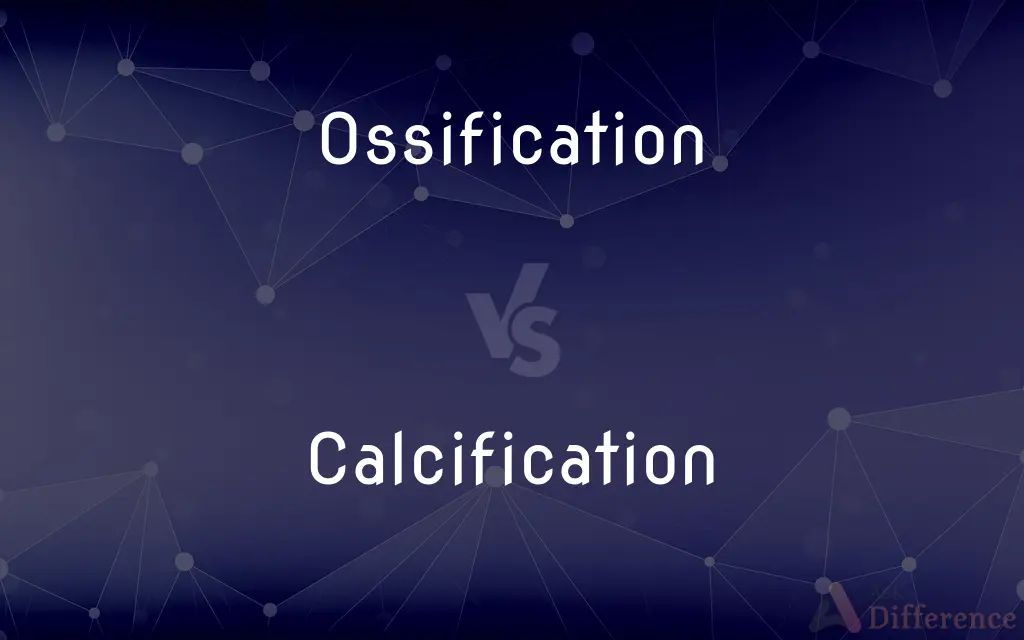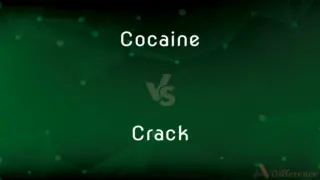Ossification vs. Calcification — What's the Difference?
By Maham Liaqat & Urooj Arif — Updated on April 16, 2024
Ossification is the process of bone tissue formation, while calcification involves the deposition of calcium salts within tissues, not limited to bones.

Difference Between Ossification and Calcification
Table of Contents
ADVERTISEMENT
Key Differences
Ossification specifically refers to the development and hardening of bone tissue, a critical process during both embryonic development and the healing of bone fractures. Whereas calcification can occur in both bone and soft tissues, involving the accumulation of calcium salts that can either be normal or pathological.
In the context of embryology, ossification is essential for the transformation of cartilage into bone, a process fundamental to skeletal development. On the other hand, calcification in embryology might be observed abnormally, indicating potential pathological issues such as calcified fibroids.
When healing broken bones, ossification is the final step where new bone is formed, restoring strength and functionality. Conversely, calcification during healing might indicate abnormal or excessive deposition of calcium, which can sometimes interfere with proper healing.
Ossification is a highly regulated process that is crucial for maintaining proper skeletal structure and function throughout an individual’s life. In contrast, calcification, especially when pathological, is often associated with diseases such as arteriosclerosis, where calcium deposits harden arterial walls.
In diseases such as osteoporosis, ossification processes are compromised, which reduces bone density and increases fracture risk. Meanwhile, calcification is often seen in soft tissues within the body, such as kidney stones, which are primarily composed of calcified crystals.
ADVERTISEMENT
Comparison Chart
Definition
The process of forming new bone tissue.
The deposition of calcium salts in tissues.
Primary Function
Essential for bone growth and repair.
Can be normal or indicate disease.
Occurrence
Limited to bones.
Occurs in bones and soft tissues.
Role in Health
Critical for skeletal integrity.
Often associated with diseases.
Examples
Formation of the skeletal system in embryos.
Kidney stones, calcified arteries.
Compare with Definitions
Ossification
Bone repair.
After a fracture, ossification helps in rebuilding the broken bone.
Calcification
Abnormal deposits
Abnormal calcification can result in stiffness and pain in joints.
Ossification
Growth plates.
Ossification occurs at the growth plates of children and adolescents.
Calcification
Pathological condition.
Pathological calcification is a common issue in chronic kidney disease.
Ossification
Conversion process.
The ossification of cartilage into bone is a key part of growing up.
Calcification
Tissue hardening.
Calcification in arteries can lead to cardiovascular diseases.
Ossification
Bone development.
Ossification is crucial for the proper development of the fetal skeleton.
Calcification
Normal process.
Calcification of bone is a normal part of the ossification process.
Ossification
Bone remodeling.
Ossification is part of ongoing bone maintenance and health.
Calcification
Mineral deposition.
Calcification often occurs in damaged or aging tissues.
Ossification
Ossification (or osteogenesis) in bone remodeling is the process of laying down new bone material by cells named osteoblasts. It is synonymous with bone tissue formation.
Calcification
Calcification is the accumulation of calcium salts in a body tissue. It normally occurs in the formation of bone, but calcium can be deposited abnormally in soft tissue, causing it to harden.
Ossification
The natural process of bone formation.
Calcification
Impregnation with calcium or calcium salts, as with calcium carbonate.
Ossification
The hardening or calcification of soft tissue into a bonelike material.
Calcification
Hardening, as of tissue, by such impregnation.
Ossification
A mass or deposit of such material.
Calcification
A calcified substance or part.
Ossification
The process of becoming set in a rigidly conventional pattern, as of behavior, habits, or beliefs.
Calcification
An inflexible, unchanging state
Calcification of negotiations.
Ossification
Rigid, unimaginative convention.
Calcification
The process of change into a stony or calcareous substance by the deposition of lime salt; -- normally, as in the formation of bone and of teeth; abnormally, as in calcareous degeneration of tissue.
Ossification
The normal process by which bone is formed.
Calcification
The process of change into a stony or calcareous substance by the deposition of lime salt; - normally, as in the formation of bone and of teeth; abnormally, as in calcareous degeneration of tissue.
Ossification
The calcification of tissue into a bonelike mass; the mass so formed.
Calcification
A process that impregnates something with calcium (or calcium salts)
Ossification
The process of becoming set in one's ways or beliefs; rigid conventionality.
Calcification
Tissue hardened by deposition of lime salts
Ossification
The formation of bone; the process, in the growth of an animal, by which inorganic material (mainly lime salts) is deposited in cartilage or membrane, forming bony tissue; ostosis.
Calcification
An inflexible and unchanging state;
The calcification of negotiations
Ossification
The state of being changed into a bony substance; also, a mass or point of ossified tissue.
Ossification
The developmental process of bone formation
Ossification
The calcification of soft tissue into a bonelike material
Ossification
The process of becoming rigidly fixed in a conventional pattern of thught or behavior
Ossification
Hardened conventionality
Common Curiosities
What is ossification?
Ossification is the process of bone formation where softer tissues are turned into bone.
What are common sites for pathological calcification?
Common sites include arteries (leading to arteriosclerosis) and soft tissues like the kidneys (leading to kidney stones).
Can ossification occur without calcification?
No, calcification is a part of ossification, where calcium salts are deposited to harden the bone tissue.
Why is calcification sometimes considered harmful?
When calcification is excessive or occurs in soft tissues, it can lead to stiffness, reduced functionality, and disease.
How does ossification contribute to growth?
Ossification contributes to growth by transforming cartilage into bone during childhood and adolescence, enabling skeletal development.
What is calcification?
Calcification refers to the deposition of calcium salts within body tissues, which can occur in both normal and pathological conditions.
Is calcification always indicative of disease?
Not always; calcification in bones during ossification is normal, but in soft tissues, it often suggests pathological conditions.
How does the body regulate ossification?
The body uses hormones, such as growth hormone and vitamin D, to regulate ossification processes.
How are osteoporosis and ossification related?
Osteoporosis results from reduced ossification rates, which decrease bone density and increase fracture risks.
What role do vitamins play in calcification?
Vitamins, particularly vitamin D, play a crucial role in regulating calcium levels in the body, affecting both normal and pathological calcification.
Share Your Discovery

Previous Comparison
Cocaine vs. Crack
Next Comparison
Grain vs. WheatAuthor Spotlight
Written by
Maham LiaqatCo-written by
Urooj ArifUrooj is a skilled content writer at Ask Difference, known for her exceptional ability to simplify complex topics into engaging and informative content. With a passion for research and a flair for clear, concise writing, she consistently delivers articles that resonate with our diverse audience.














































